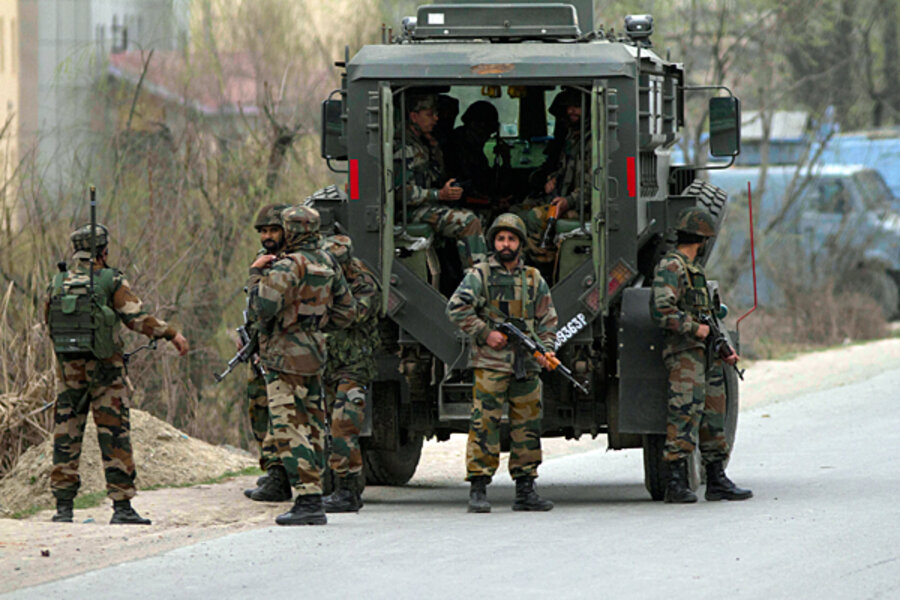After years of nonviolent protest, could Kashmiris return to the gun?
Loading...
| Srinagar, Indian-administered Kashmir
Heavily-armed rebels attacked a police compound in Srinagar, the main city of Indian-controlled Kashmir, killing five Indian paramilitaries on Wednesday before the government forces killed the two attackers.
The attack that also injured five other personnel of the federal Central Reserve Police Force (CRPF) was claimed by Kashmir’s largest pro-Pakistan militant group, the Hizbul Mujahideen. Kashmiri leaders are warning that the region's youth may be taking to arms again after their transition to nonviolent mass street protests against Indian rule largely went unheeded by New Delhi and the international community.
Kashmir is divided between nuclear-armed South Asian rivals India and Pakistan by a line of control established in 1947 when the departing British portioned the subcontinent. The two countries have fought two of their three wars over the disputed Himalayan territory which they both claim in full.
From 2008, Indian-ruled Kashmir witnessed three consecutive summers of unrest that marked a transition from the armed uprising against Indian rule, that began in 1989, to a nonviolent mode of mass street protests. Government action to quell the unarmed protest by rock-throwing youth left nearly 200 dead.
“Such transitions take a very long time to come about. The international community must end its criminal silence and pressure India to resolve the Kashmir dispute,” says Yasin Malik, the chairman of the Jammu Kashmir Liberation Front, whose group gave up arms in 1994 in favor of a “nonviolent democratic movement” for gaining freedom from Indian rule. “The transition to non-violent democratic methods was not respected by any one."
The 23-year-old anti-India insurgency has waned since 2003; overall, the conflict has left an estimated 70,000 people dead, mostly civilians.
Experts say New Delhi’s refusal to seriously begin efforts to resolve the dispute over Kashmir poses a real danger of a return to a renewed armed rebellion by the Kashmiri youth who feel pushed to the wall. Many here also say that the NATO withdrawal from Afghanistan in 2014 might again provide militants from there a “cause” in Kashmir.
“The opportunity after nonviolent mass uprising of 2010 to resolve Kashmir was not availed by New Delhi and the situation could push the youth who face state brutality for a political response to their demands to arms again,” says Sheikh Showkat Hussain, a professor of international human rights law at a central university in Srinagar.
In the aftermath of the 2010 uprising, the government of India appointed three interlocutors to suggest a political solution to the Kashmir dispute, but within the boundaries of the Indian Constitution. None of the many recommendations of the three were given an ear by New Delhi, prompting one of them, professor Radha Kumar, to say, “the government was not serious in resolving the dispute.”
Various separatists opposed to Indian rule of the territory had refused to meet with the three interlocutors, since the mandate for the three was to remain within the Indian Constitution. They claimed that they were vindicated when New Delhi "dumped" their own interlocutors' recommendations.
The Kashmir valley has witnessed a wave of protests, crippling business shutdowns called by the separatists, and curfew restrictions since Feb. 9 when a Kashmiri Muslim Mohammad Afzal Guru was hanged and buried in a high security prison in New Delhi.
Mr. Guru was convicted for his role in the deadly attack on India’s parliament in 2001 in which 10 people died. Many in Kashmir and among Indian civil society contend that Guru did not receive a fair trial.
The protests over Guru’s secretive execution lead to the killings of four persons at the hands of Indian forces in Kashmir. On Wednesday, Indian paramilitaries killed another man when they came under attack by stone-throwing protesters demanding the return of Guru’s body to his family in Kashmir, police said.
However, witnesses contested the police claim saying CRPF soldiers killed Altaf Ahmed Wani when they fired at him from a moving armored vehicle. “There was no protest or stone throwing happening in the area, he was killed in cold blood in retaliation to the militant attack earlier in the day,” said a witness, who declined to give his name for fear of his own safety.
Wednesday’s attack on the Indian paramilitaries is also being seen as an indication of a return to armed militancy in the territory. The Hizbul Mujahideen militants came disguised as cricket players onto a sports field, hiding their weapons in the cricketing gear bags they were carrying, according to the CRPF spokesperson in Srinagar.
Suspected rebels also killed a village council head last month in northern Kashmir. Pro-India groups in Indian Kashmir boasted of the election of more than 35,000 village representatives, which registered a huge turnout of voters, as a watershed moment of grassroots democracy. Dozens of the village representatives have since resigned demanding state security.







